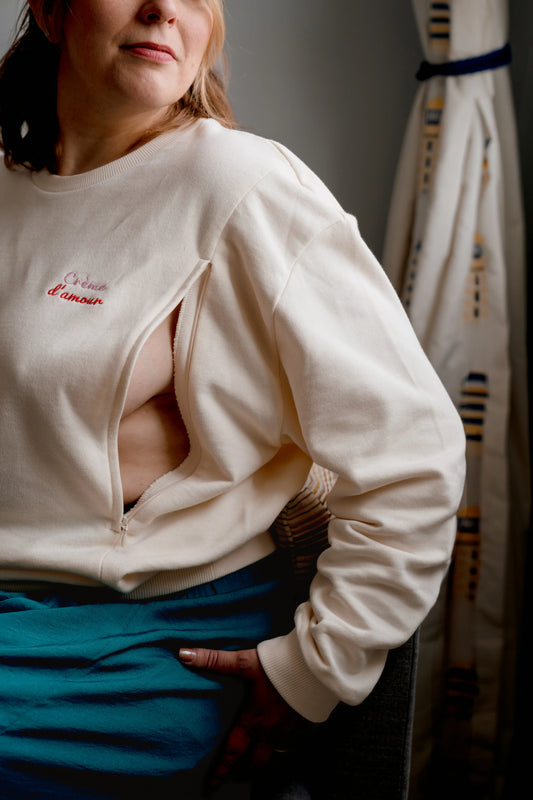
How to prevent cracks when breastfeeding?
Share
Preventative measures mothers can take to avoid cracked nipples while breastfeeding.
Tips on breastfeeding position, using moisturizers, and other tips for maintaining healthy skin.
I - Introduction
Breastfeeding is a precious and irreplaceable experience for many mothers and their babies. However, it can be accompanied by certain challenges, one of the most common of which is the appearance of cracked nipples. Cracked nipples , although often painful and discouraging, can be avoided with proper preventative measures.
The Importance of Crevice Prevention
When talking about breastfeeding, it is essential to focus on preventing cracked nipples , as it can have a significant impact on a mother's breastfeeding experience and the health of the infant. Here's why preventing cracked nipples is of paramount importance:
1- Comfort of the Mother:
Cracked nipples can cause intense pain, making breastfeeding uncomfortable or even unbearable for some mothers. Persistent pain can also discourage continued breastfeeding, which is detrimental to the baby's health.
2 - Baby's Health:
When breastfeeding is painful for the mother due to cracked nipples, it can affect the frequency and quality of feedings. A baby may not breastfeed as effectively or as often, which can lead to reduced nutritional intake and impact growth.
3- Maintain a Positive Breastfeeding Relationship:
Breastfeeding is much more than just feeding. It's a time of intimate connection between mother and baby. Cracked nipples can lead to stress, frustration, and negative feelings, which can harm the breastfeeding relationship.
4 - Save Time and Money:
Treating cracks after they appear often requires time and resources for creams or other skincare products. Therefore, preventing cracks can save you time and money.
Ultimately, preventing cracked nipples is an investment in a more comfortable breastfeeding experience for the mother and a more beneficial one for the baby. In this article, we'll explore in detail the preventative measures mothers can take to avoid cracked nipples while breastfeeding. From the correct breastfeeding position to skin hydration and practical tips, we'll provide a comprehensive guide to help you fully enjoy this special time with your baby.
II - Understanding Crevasses
Cracked nipples , often feared by breastfeeding mothers, are cracks or skin lesions that usually form on the nipples during breastfeeding. To better prevent them, it is essential to understand their origin and the consequences they can have for both mother and baby.
Definition of Cracks and Their Causes
Cracked nipples are small sores that develop on a mother's nipples during breastfeeding. They are usually the result of the baby's improper latching on. Common causes of cracked nipples include:
-
Incorrect Position:
A poor breastfeeding position can cause the baby to latch on poorly, which can cause friction and injury to the nipple.
-
Bad Attachment:
If the baby does not latch on properly, he or she may pinch the nipple between his or her tongue and the roof of his or her mouth, causing cracks .
-
Dry Skin:
Dry, dehydrated skin is more likely to crack. Exposure to dry air, harsh soaps, or wearing tight-fitting bras can contribute to dry skin.
-
Frequent or Long Feedings:
If the baby feeds frequently or for long periods without breaks, this can cause excessive friction on the nipple.
The Consequences of Cracked Skin for Mother and Baby
Cracked nipples can have significant consequences for both mother and baby, further highlighting the importance of prevention:
To learn more about breastfeeding rhythms, I invite you to consult our article here.
For the Mother:
- Pain and Discomfort: Cracked nipples cause a stabbing pain that can persist between feedings and make breastfeeding painful.
- Stress and Frustration: Constant pain can cause stress, frustration and sometimes even depression in the mother.
- Reduced Self-Confidence: Cracked nipples can make a mother doubt her ability to feed her baby effectively.
For the Baby:
- Difficulty Latching: Cracked nipples can make it difficult for the baby to latch on, which can lead to ineffective sucking.
- Reduced Nutrient Intake: If the baby is not breastfeeding properly due to cracked nipples , this can impact their nutritional intake.
- Frustration and Restlessness: A baby who is unable to breastfeed effectively may become frustrated and restless.
In summary, understanding cracked nipples , their causes, and consequences is essential for taking appropriate preventive measures. In the following sections of this article, we will discuss in detail strategies to avoid these inconveniences and make the breastfeeding experience more comfortable for both mother and baby.
III. Correct Breastfeeding Position
One of the crucial steps to preventing cracked nipples while breastfeeding is adopting a proper breastfeeding position. A good position offers many benefits for both mother and baby and reduces the risk of nipple injury.
Importance of a Proper Breastfeeding Position
A correct breastfeeding position is essential for several reasons:
-
Good Latch:
Proper positioning allows the baby to latch firmly on the breast, covering the nipple and a large portion of the areola. This reduces excessive friction on the nipple.
- Pressure Balancing:
Correct position distributes the pressure exerted by the baby's mouth evenly on the nipple, minimizing friction points.
-
Reduction of Muscle Tension:
For the mother, a proper position reduces muscle tension in the back, shoulders and neck, which promotes comfortable and sustained breastfeeding.
IV - Illustration of Recommended Positions
Here are some recommended breastfeeding positions to help prevent cracked nipples :
- Baby Tummy to Tummy Position:
Place your baby tummy to tummy with you, so that their head is aligned with your nipple. This facilitates a good latch and effective sucking.
- Position of the Madonna:
Sit with the baby at your side, facing you. Hold the baby's head with the hand on the same side as the breast you are breastfeeding. Use your other hand to support your breast.
- Rugby Position:
Hold the baby under your arm, like a rugby ball. His head should be supported by your hand, and your breast should be accessible so he can latch on properly.
- Lying Position:
Lie comfortably with the baby next to you. This position is especially useful for nighttime feedings.
Tips for Maintaining a Comfortable Position
To maintain a comfortable breastfeeding position, here are some practical tips:
- Make sure you have enough pillows to support your back, arms, and the baby.
- Use a stool or footrest to elevate your knees slightly, which can relieve back strain.
- Keep a water bottle handy to stay hydrated while breastfeeding.
- Don't hesitate to use nursing pads to absorb any milk leaks.
By adopting a proper breastfeeding position and following these tips, you can significantly reduce the risk of developing cracked nipples and make the breastfeeding experience more enjoyable for you and your baby.
V - Skin Hydration
Skin hydration is a crucial aspect of preventing cracked nipples while breastfeeding. Well-maintained skin is more resistant to irritation and injury, contributing to a more comfortable and enjoyable breastfeeding experience.
The Importance of Keeping Skin Healthy
The skin surrounding the nipples is delicate and can become dry, making it more likely to develop cracks . Keeping your skin healthy is essential to prevent them. Here's why:
- Prevention of Cracks:
Well-hydrated skin is less prone to cracks and crevices , even during frequent and vigorous breastfeeding.
- Comfort :
Dry skin can become itchy and painful. Proper hydration can relieve itching and tightness.
- Preparation for Breastfeeding:
Maintaining healthy skin before your baby is born can help you anticipate a more enjoyable breastfeeding experience from the start.
Use of Specific Moisturizing Creams
To maintain healthy skin and prevent cracks , the use of moisturizers specially designed for nipples and sensitive skin is highly recommended. Here's how to use them effectively:
- Choose suitable creams: Opt for creams made with natural ingredients such as lanolin creams, and without perfume, as perfumes can be irritating to delicate skin.
- Gentle application: Gently apply the cream to the skin of the nipples and areola after each feeding. Avoid vigorous rubbing, which may further irritate the skin.
- Cleansing before feeding: Before each feeding, gently cleanse the skin to remove any excess cream, then allow it to air dry.
Other Skin Care to Consider:
In addition to using specific moisturizers, here are some other skin care tips to consider to prevent cracks :
- Fresh Air Exposure: After each feeding, leave your nipples uncovered for a few minutes to promote healing and air circulation.
- Avoid Tight Bras: Choose well-fitting bras that do not compress the nipples.
- Use Soft Nursing Pads: Soft and absorbent nursing pads can protect your nipples from moisture while providing comfort.
By taking proper care of your skin and using the right moisturizers, you can strengthen your skin barrier and minimize the risk of cracks during breastfeeding. This will contribute to a more pleasant breastfeeding experience for both you and your baby.
VI - Tips and practical advice
To prevent cracked nipples and make breastfeeding more comfortable, there are several practical tips and tricks you can follow throughout your breastfeeding journey. Here are some key recommendations:
2- Frequency of Feedings and Their Duration
It is important to maintain an appropriate feeding frequency and duration to avoid nipple fatigue and minimize the risk of cracked nipples. Here are some key points to consider:
- Frequent Feedings: Give your baby the opportunity to feed frequently, according to their needs. Regular feedings stimulate milk production and reduce pressure on the nipples.
- Ensure the baby empties the breast properly: Ensure the baby empties the breast properly at each feeding. A baby who latches effectively minimizes unnecessary friction.
- Using Nursing Pads
Nursing pads are valuable allies in preventing cracks :
- Moisture Absorption: Nursing pads absorb moisture and prevent your nipples from remaining wet after feedings, which could increase the risk of cracked nipples .
- Comfort and Protection: They also provide a protective cushion between your nipples and your clothing, reducing friction.
- Breast Alternation
To prevent overuse of a single nipple and minimize the risk of cracked nipples , consider alternating between breasts regularly:
- Switch breasts at each feeding: Start with one breast at one feeding, then switch to the other at the next feeding. This allows each breast to rest between feedings.
- The Importance of Effective Suction
Effective suction is essential to prevent cracks . Here are some things to consider:
- Make sure the baby is properly attached: A good latch is essential for effective sucking. Make sure the baby's mouth covers the nipple and part of the areola.
- Observe effective sucking cues: When the baby is sucking effectively, you can observe regular swallowing movements and hear sucking sounds.
- Ask for help if needed: If you have any doubts about your baby's sucking or if you experience pain despite a good latch, do not hesitate to consult a lactation consultant or a healthcare professional.
By applying these practical tips and advice, you can create optimal conditions to prevent cracked nipples while breastfeeding. These small adjustments can make a big difference in your breastfeeding experience, making it more enjoyable for both you and your baby.
VII - Mental and Emotional Preparation
Preventing cracked nipples isn't just about physical care, it's also about the mental and emotional preparation of breastfeeding mothers. A positive attitude and emotional support are essential for successfully navigating this journey.
- Managing Breastfeeding Stress
Breastfeeding can be a time of joy and connection, but it can also be a time of stress, anxiety, and self-doubt. Managing breastfeeding stress is essential to prevent cracked nipples :
- Educate yourself: Learn as much as you can about breastfeeding and preventative care so you feel better prepared.
- Communicate: Share your concerns with your partner, a friend, a family member, or a lactation consultant. Simply talking about your worries can help alleviate them.
- Practice relaxation: Meditation, deep breathing, or yoga can help you reduce stress and stay calm while breastfeeding.
- The Importance of Social Support
Social support plays a crucial role in preventing cracks :
- Surround yourself with positive people: Seek support from people who are supportive of your choice to breastfeed and who can offer you caring advice.
- Join support groups: Breastfeeding support groups can be a valuable source of advice and comfort. You can share your experiences and get advice from mothers who have gone through similar situations.
- Consult a lactation consultant: If you are having difficulties, do not hesitate to consult a certified lactation consultant who can help you resolve problems and build your confidence.
- Self-Care for Breastfeeding Mothers
Don't neglect the importance of self-care as a breastfeeding mother:
- Balanced Diet: Make sure you eat healthy and stay hydrated to promote optimal skin recovery.
- Adequate rest: Sleep is essential for your well-being. Try to rest whenever possible, timing your naps with your baby's.
- Take time for yourself: Allow yourself moments of relaxation, whether it's reading a book, taking a relaxing bath, or practicing a hobby you enjoy.
By preparing yourself mentally and emotionally, seeking strong support, and practicing self-care, you strengthen your ability to prevent cracked lactates while creating a more harmonious breastfeeding experience for you and your baby. Emotional well-being is an essential element in navigating this time positively.
Conclusion
In your breastfeeding journey, preventing cracked nipples is a crucial step to ensure the mother's comfort and the baby's health. By summarizing the preventative measures discussed in this article, we hope to help you fully enjoy this unique and precious experience:
Summary of Preventive Measures:
- Correct Breastfeeding Position: Adopt a proper breastfeeding position to avoid unnecessary friction and ensure a good latch for the baby.
- Skin Hydration: Keep your skin healthy by using specific moisturizers and practicing appropriate care.
- Tips and Practical Advice: Maintain an adequate feeding frequency, use nursing pads, alternate between breasts, and ensure effective suction.
- Mental and Emotional Preparation: Manage breastfeeding stress, seek social support, and practice self-care to strengthen your emotional well-being.
Encouraging a Proactive Approach to Crevice Prevention:
Preventing cracked nipples is a proactive approach that requires attention, persistence, and support. Remember that every woman and baby are different, and it's perfectly normal to encounter challenges along the way.
Never hesitate to ask a healthcare professional or lactation consultant for help if you experience difficulties despite your preventative efforts. They are there to support and guide you on your breastfeeding journey.
Breastfeeding is a special time of connection and nourishment for you and your baby. By taking these preventative measures and staying positive, you can fully enjoy this unique experience while maintaining the well-being of both you and your little one.
We wish you a happy, comfortable, and fulfilling breastfeeding journey!






















